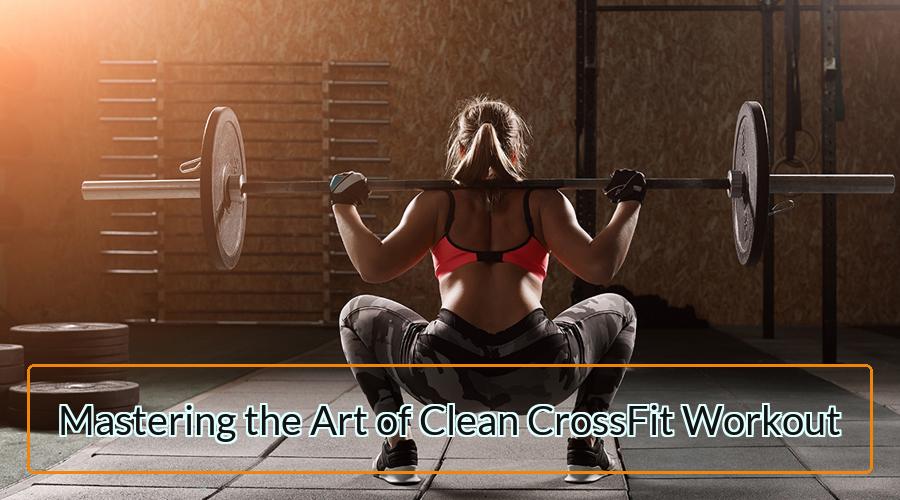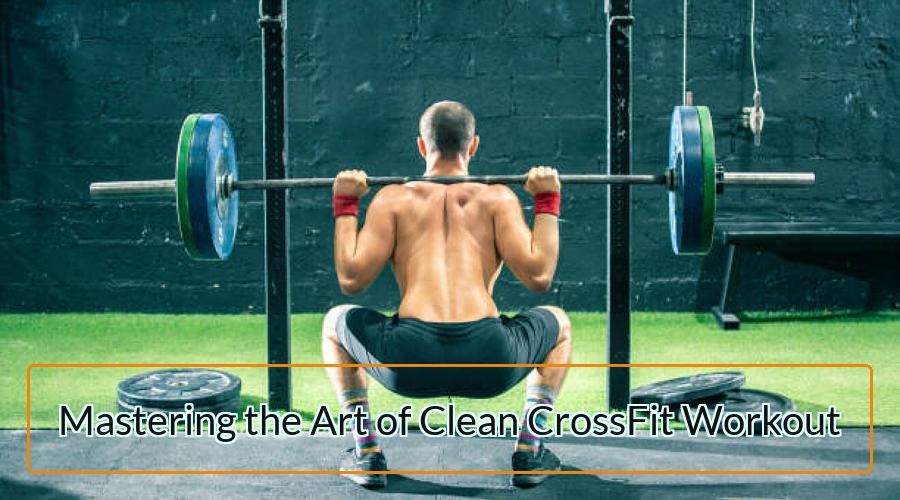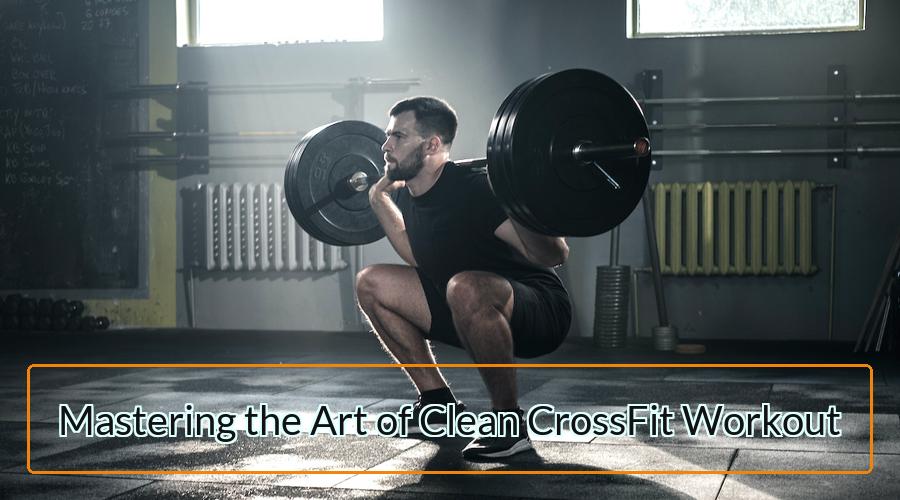
CrossFit has been gaining popularity in recent years as an intense and challenging form of exercise that promises to deliver amazing results. However, the focus on pushing oneself to the limit can sometimes lead to injuries or burnout. This is where the concept of a “clean CrossFit workout” comes in – a training style that prioritizes proper form, injury prevention, and sustainability.
In this blog post, we’ll dive into the world of clean CrossFit and explore what it means to train in a way that is both effective and safe. We’ll cover tips and techniques for optimizing your form and avoiding common mistakes, as well as strategies for building strength and endurance over the long term. Whether you’re a seasoned CrossFitter looking to take your training to the next level, or a beginner who wants to get started on the right foot, this post has something for everyone.
So, what does it take to achieve optimal results with a clean CrossFit training? Join us as we explore the science behind this training style and share our top recommendations for making the most of your CrossFit journey.
What is CrossFit?
CrossFit is a fitness program that combines strength training, high-intensity interval training (HIIT), and functional movements to create a challenging and varied workout. It was founded by Greg Glassman and Lauren Jenai in 2000 and has since grown into a global fitness phenomenon with over 13,000 affiliate gyms in more than 150 countries.
The key to CrossFit is its focus on functional movements, which are movements that mimic everyday activities and improve overall fitness and health. These movements include exercises like squats, deadlifts, push-ups, pull-ups, and other bodyweight movements, as well as Olympic weightlifting movements like the clean and jerk and the snatch.
One of the defining features of CrossFit is its emphasis on community and support. CrossFit gyms, also known as “boxes,” are known for their tight-knit communities and supportive environments, where members cheer each other on, share advice and tips, and push each other to achieve their fitness goals. CrossFit is not just a workout program but a lifestyle that encourages people to prioritize their health and wellness and to support one another in their fitness journeys.
Overview of the Concept of a Clean Crossfit Workout
The concept of a “clean CrossFit workout” is a training style that prioritizes proper form, injury prevention, and sustainability. While CrossFit is known for its intensity and challenging workouts, this can sometimes lead to injuries or burnout if proper form is not emphasized. Clean CrossFit training focuses on training in a way that is both effective and safe, with the goal of achieving optimal fitness results in the long term.
To achieve a clean CrossFit, athletes must prioritize proper form and technique. This means starting with lighter weights and gradually increasing the load as the form improves. CrossFit coaches often emphasize the importance of proper body mechanics, such as keeping the core engaged, maintaining a neutral spine, and keeping the knees in line with the toes during exercises like squats and deadlifts.
In addition to proper form, a clean CrossFit exercise also prioritizes injury prevention and sustainability. This means incorporating rest days into the training schedule, as well as taking time for recovery and mobility work. By training in a way that is safe and sustainable, athletes can avoid burnout and achieve long-term fitness goals.
Prioritizing Proper Form
The risks of improper form in CrossFit
Proper form is essential in CrossFit to avoid injuries and achieve optimal results. The risk of injury is higher in CrossFit due to the high-intensity nature of the workouts and the complex movements involved. Improper form can lead to a range of injuries, from strains and sprains to more serious injuries like torn ligaments and herniated discs. In addition to injury, improper form can also lead to suboptimal results, as the intended muscles may not be engaged effectively.
To avoid injury and achieve optimal results, athletes must prioritize proper form in their workouts. This means focusing on technique over weight or speed, and starting with lighter weights and simpler movements before progressing to more complex exercises. CrossFit coaches can provide guidance and feedback on proper form, and athletes should listen to their bodies and avoid pushing themselves beyond their limits.
Techniques for optimizing form and preventing injury
There are several techniques athletes can use to optimize form and prevent injury in their CrossFit workouts. One of the most important is to maintain a neutral spine during exercises like squats and deadlifts. This means keeping the natural curve of the spine and avoiding rounding or arching the back. Other techniques include engaging the core, keeping the knees in line with the toes, and avoiding excessive forward lean during exercises like lunges and split squats.
Another key technique is to use proper breathing patterns during exercises. This means exhaling during the exertion phase of the movement and inhaling during the relaxation phase. Proper breathing can help stabilize the core and improve performance while reducing the risk of injury.
Finally, athletes should prioritize mobility work and flexibility training to improve range of motion and prevent muscle imbalances. This can include exercises like foam rolling, stretching, and mobility drills that target specific areas of the body.
Common mistakes to avoid
There are several common mistakes that athletes should avoid in their clean crossfit workout to prioritize proper form and prevent injury. One of the most common is using too much weight or trying to move too quickly without first mastering proper form. This can lead to compensatory movements or improper techniques that can increase the risk of injury.
Another common mistake is neglecting rest and recovery. Rest is essential for muscle repair and growth, and athletes who overtrain or neglect rest days are more likely to experience injury or burnout. Similarly, neglecting proper nutrition and hydration can also increase the risk of injury and lead to suboptimal results.
By prioritizing proper form, athletes can reduce the risk of injury and achieve optimal results in their CrossFit workouts. This means starting with lighter weights, focusing on technique over speed, and incorporating rest and recovery into the training schedule. With these techniques, athletes can enjoy the benefits of CrossFit without compromising their health or performance.

Building Strength and Endurance
Strategies for progressive overload
Building strength and endurance is a key component of a successful CrossFit program. One of the most effective strategies for building strength is progressive overload, which involves gradually increasing the resistance or intensity of the exercise over time. This can be done by increasing the weight lifted, the number of repetitions, or the duration or intensity of the exercise.
Another effective strategy is to incorporate compound exercises that engage multiple muscle groups at once, such as squats, deadlifts, and pull-ups. These exercises are more challenging and require more energy, which can lead to greater strength and endurance gains over time.
To optimize results, it’s important to track progress and adjust the training program accordingly. This can involve increasing the resistance or intensity of the exercise as progress is made, or varying the exercises to challenge the body in new ways.
Importance of rest and recovery
Rest and recovery are just as important as training itself when it comes to building strength and endurance. During rest periods, the muscles have time to repair and rebuild, which can lead to greater strength gains over time.
It’s important to incorporate rest days into the training schedule and avoid overtraining, which can lead to injury and burnout. Recovery techniques such as foam rolling, stretching, and massage can also be effective in reducing muscle soreness and promoting recovery.
Another important aspect of recovery is proper nutrition and hydration. This can include consuming protein-rich foods and adequate carbohydrates to fuel workouts, as well as staying hydrated to support muscle function and recovery.
Incorporating functional training
In addition to traditional strength and endurance exercises, incorporating functional training into a CrossFit program can lead to real-world fitness benefits. Functional training involves exercises that mimic everyday movements, such as lifting groceries or climbing stairs.
Incorporating functional training into a CrossFit program can help improve balance, stability, and coordination, as well as reduce the risk of injury in everyday activities. Exercises such as lunges, farmer’s carries, and box jumps are all examples of functional training that can be incorporated into a CrossFit program.
Nutrition for CrossFit Performance
Nutrition is a crucial aspect of clean crossfit workout performance, as it provides the fuel and nutrients necessary to support intense training and optimize results. Proper nutrition can help athletes build strength and endurance, improve recovery times, and reduce the risk of injury and illness. Here are some key aspects of nutrition for CrossFit performance:
- Macronutrient Balance – Athletes should aim for a balanced macronutrient ratio of carbohydrates, protein, and fat. Carbohydrates provide the energy necessary for intense workouts, while protein is essential for muscle repair and growth. Fat is also important for providing energy and supporting hormone function.
- Pre- and Post-Workout Nutrition – Pre-workout nutrition should focus on carbohydrates for energy and protein for muscle support. A good pre-workout meal might include a mix of complex carbohydrates like brown rice or sweet potatoes, along with lean protein like chicken or fish. Post-workout nutrition should focus on protein and carbohydrates to support muscle recovery and glycogen replenishment.
- Hydration and Electrolytes – Adequate hydration and electrolyte balance are crucial for CrossFit performance. Athletes should aim to drink at least 8-10 glasses of water per day, and more during intense workouts. Electrolytes like sodium, potassium, and magnesium can also be added to water or sports drinks to help maintain fluid balance and support muscle function.
- Supplements – While a well-rounded diet should provide all the necessary nutrients for CrossFit performance, some athletes may benefit from supplements like protein powder or creatine to support muscle growth and recovery.
Overall, nutrition plays a critical role in CrossFit performance, and athletes should prioritize a well-rounded diet that provides the fuel and nutrients necessary to support intense training and optimize results. With proper nutrition, athletes can build strength and endurance, improve recovery times, and reduce the risk of injury and illness.

Mindset and Motivation
CrossFit is not just a physical challenge, but a mental one as well. The right mindset and motivation can make all the difference in achieving success and overcoming obstacles in a CrossFit program. Here are some key aspects of mindset and motivation for CrossFit:
- Overcoming Mental Barriers – CrossFit can be intimidating, especially for beginners. It’s important to overcome mental barriers and believe in oneself to succeed. Practicing positive self-talk, setting achievable goals, and focusing on progress rather than perfection can all help overcome mental barriers.
- Developing a Growth Mindset – A growth mindset is essential for long-term success in CrossFit. This means viewing challenges and failures as opportunities for growth, rather than as obstacles. Athletes with a growth mindset are more likely to persist through challenges and continue to improve over time.
- Finding Motivation and Accountability – CrossFit is more fun and effective with a community of like-minded individuals who can provide support and accountability. Joining a CrossFit gym or finding a workout partner can provide the motivation and encouragement necessary to succeed.
- Visualization and Mental Preparation – Mental preparation is just as important as physical preparation in CrossFit. Athletes can use visualization techniques to mentally prepare for workouts and visualize success. They can also set intentions and focus on the task at hand to improve performance.
Overall, mindset and motivation are critical aspects of CrossFit’s performance. Athletes should focus on overcoming mental barriers, developing a growth mindset, finding motivation and accountability, and using visualization and mental preparation to achieve success. With the right mindset and motivation, CrossFit can be a fulfilling and rewarding fitness journey.
Conclusion
CrossFit is a high-intensity fitness program that combines various functional movements from weightlifting, gymnastics, and other sports to create a challenging and intense workout. However, it’s essential to prioritize proper form, injury prevention, and sustainability in a CrossFit program. By focusing on techniques such as proper form and breathing patterns, tracking progress, and incorporating rest and recovery, athletes can achieve optimal results and reduce the risk of injury and burnout.
Nutrition also plays a critical role in CrossFit performance, providing the fuel and nutrients necessary to support intense training and optimize results. A well-rounded diet that provides a balanced macronutrient ratio, pre- and post-workout nutrition, hydration, and electrolyte balance can all help support muscle growth, endurance, and recovery.
Finally, mindset and motivation are crucial aspects of CrossFit performance. Overcoming mental barriers, developing a growth mindset, finding motivation and accountability, and using visualization and mental preparation can all help athletes achieve success and overcome obstacles in their fitness journey.
Overall, a clean crossfit workout can be a challenging but rewarding fitness program that promotes community, functional movement, and overall wellness. By prioritizing proper form, nutrition, and mindset, athletes can achieve optimal results and enjoy the benefits of a successful CrossFit program.